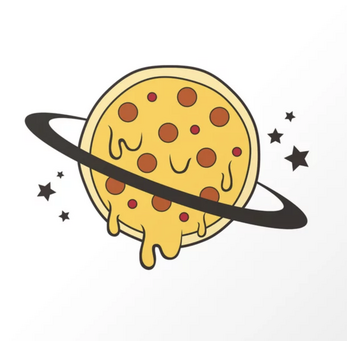Pizza Time
Room 1 - The beginning room is the “present” time in which it illustrates an industrious background. The dull and dark green is something that reminds me of a booming and bustling society. There is only one sprite available to interact with but this room also immediately displays the key item.
Room 2 - This room is a dramatic shift from the first one. It is an alarming red and features tanks and planes shooting in every direction. This is meant to be WW2 which shows the player went too far back into the past. One of the planes is shooting a pointing arrow towards the character’s car to indicate the hidden exit.
Room 3 - The blue background, animated seaweed, fish and sea-people show a futuristic society where humans are forced to live underwater. This room is much more relaxing than room 2 and allows the player a second to breathe from the glaring red background of the room before.
Room 4 - an extension of room three allows the player to sink further into the society of the future. Reveals just a little more of the underwater society humans are now a part of.
Room 5 - The final room is reminiscent of room 1 as they are similar, however it features a house rather than commercial property. This is the concluding scene as the bird from the beginning is also there to greet us at the end.
McCloud says our minds have no trouble connecting the dots into something more recognizable. He also states that we tend to see ourselves in everything, even inanimate objects (pg. 32). In Bitsy, I tried to embrace the limitations of the pixel art and created an extremely basic and raw representation of what I wanted to show. I created smoke with tiny black dots and animating them into blinking tiny black dots. I also designed very boxy silhouettes meant to represent people with no clear distinctions from one another.
McCloud also mentions the concept of closure which is when we can observe bits and pieces of an object, image, etc. and also perceive the whole of that object, image, etc. (pg. 62). Closure will help people make sense of the transitions of the character as they are being sent back and forth through time. I also picked a transition/exit effect. The effect is called “wave” as the entire image moves like a wave before showing the new room. I liked this option best as I felt it best fit with the idea of a time traveling pizza delivery plot.
Another topic that McCloud talks about, and an extremely important one, is timeframe. The timeframe refers to the amount of time passing between the images in the panel. I found the idea that the panel itself plays an unappreciated role as it has an impact on the story and reader. It was difficult for me to apply this complex concept onto the limiting tiles of Bitsy, however, I realized the by extending room three and using the sliding effect, I was able to elongate the room to the player. It felt like a nice change of pace rather than transitioning through all the rooms with a disrupting wave of pixels.
| Status | Released |
| Platforms | HTML5 |
| Author | fernandaxcalvo |
| Genre | Interactive Fiction |
| Made with | bitsy |

Leave a comment
Log in with itch.io to leave a comment.